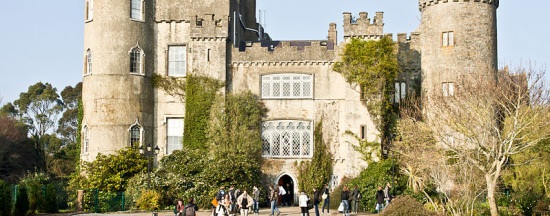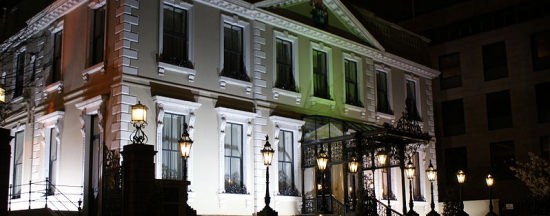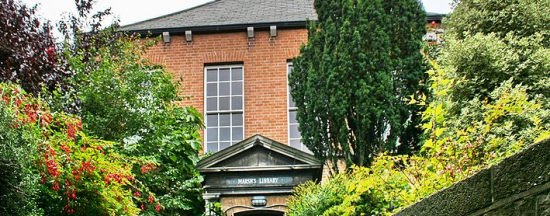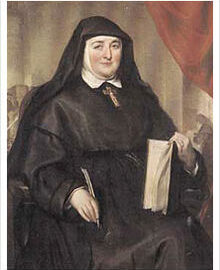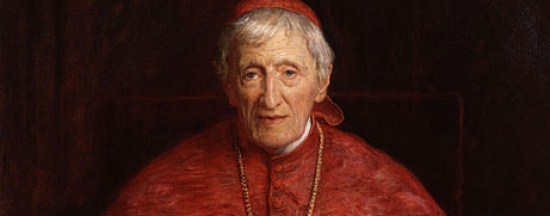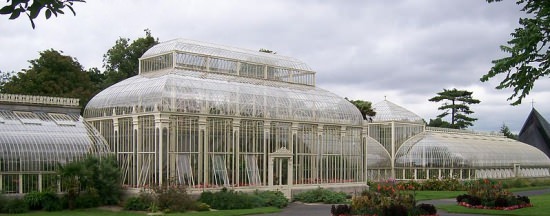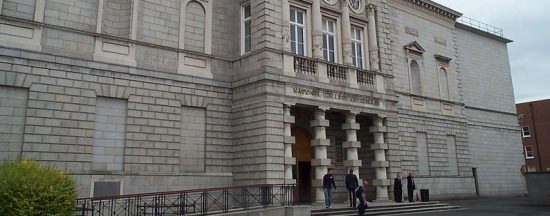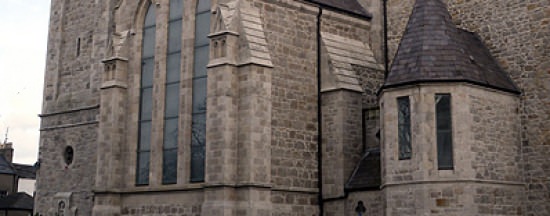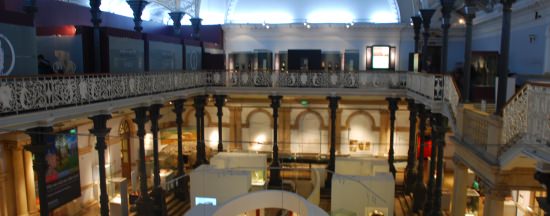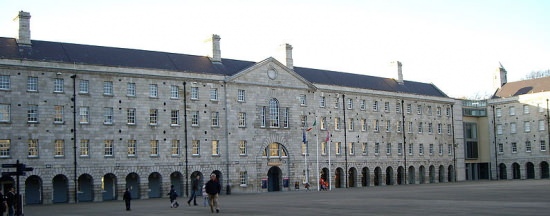In 1852 William Dargan, the father of the Irish rail network, approached the Royal Dublin Society (RDS) with an offer to underwrite a spectacular exhibition on Leinster Lawn in Dublin, the home of the RDS at the time. Just eleven months later, the exhibition was opened in an astonishing series of pavilions for which the architect, John Benson, received a knighthood. The enthusiastic response of the visiting crowds demonstrated an active interest in the establishment of a permanent public collection.
The next ten years saw active campaigning for the funding of a new Gallery building which was designed by Francis Fowke. In January 1864, the Earl of Carlisle officially opened the National Gallery of Ireland to the public. The collection consisted of just 112 pictures, including 39 purchased in Rome in 1856 and 30 which were on loan from the National Gallery London and elsewhere.
The Gallery thrived over the years through purchases, bequests and donations. In 1901 the Countess of Milltown gifted over 200 pictures to the gallery from her house at Russborough as well as a collection of silver, furniture and books from her library. The gift was so substantial that a new extension was constructed to accommodate it.
In 1968 the gallery was extended again with designs by Frank DuBerry. This extension is today named the Beit Wing in acknowledgement of the generosity of Sir Alfred and Lady Beit who gifted 17 outstanding old master pictures to the nation in 1987. Some six years later in 1993 the Gallery became the focus of international attention when Caravaggio’s, ‘The Taking of Christ’, a painting recorded in contemporary biographies on the artist and known through copies but long believed to be lost or destroyed, was discovered in a Jesuit house of studies in Dublin. The picture remains in the gallery on indefinite loan from the Jesuit fathers.
The National Gallery houses some 15,000 paintings, sculptures, works on paper and objets d’art dating from the early thirteenth century through to the mid-twentieth century. The collection boasts an impressive range of masterpieces by artists from the major European schools of art whilst also featuring the world’s most comprehensive collection of Irish art.
In June 2017 the Gallery re-opened to the public following a period of extensive refurbishment and modernisation of its historic wings on Merrion Square. The grand scale of the Shaw Room at entry level and the monumental galleries in the Dargan and Milltown wings now give the displays a renewed sense of space and grandeur.
The beautifully transformed spaces now feature an entirely new presentation of the celebrated permanent collection featuring master paintings by Rembrandt, Caravaggio, Ruisdael, Vermeer, Gainsborough, Goya, Monet, Gris and Picasso. The Gallery is also able to once again display its prestigious collection of Irish art with works by Daniel Maclise, Roderic O’Conor, John Lavery, William Orpen, Seán Keating, Gerard Dillon, Evie Hone, Norah McGuinness, Jack B. Yeats, Louis le Brocquy and William Scott.
This multimillion-euro refurbishment project was carried out by the Office of Public Works’ Project Management Services, with architects Heneghan Peng as the Design Team Leaders.
Central to the modernisation work was the construction of a state-of-the-art underground energy centre housing vital services. Original nineteenth-century architectural features and spaces are revealed and majestic windows now open onto a spacious light-filled courtyard. The new courtyard dramatically enhances visitors’ orientation between the historic Dargan and Milltown wings. It is also the site for a dramatic sculpture, Magnus Modus, by Joseph Walsh.
The period of refurbishment also allowed for an extensive survey of the Gallery’s permanent collection. More than 450 works have undergone conservation and research. The most spectacular of these is Daniel Maclise’s The Marriage of Strongbow and Aoife (1854), which has been returned to the elegant surrounds of the Shaw Room in the Dargan Wing.
The refurbished galleries on Merrion Square display over 650 works of art from the permanent collection presented broadly chronologically. The Irish collections are prominent at ground level with European art on the upper level.
An integral part of Gallery is the National Portrait Collection which shows works of eminent Irishmen (Seamus Heaney, TK Whitaker, Brian Friel) and Irishwomen (Mary Robinson, Sr Stanislaus Kennedy) who have contributed to the social, historic, cultural and political life of the country. Most recent acquisitions include portraits of Tony award winning theatre director, Garry Hynes by Vera Klute a portrait of Graham Norton by Gareth Reid, commissioned as part of Sky Arts Portrait Artist of the Year 2016, and a portrait of Henry Shefflin by Gerry Davis, commissioned as part of the Hennessy Portrait Prize 2016.
The Gallery complex consists of four interconnected buildings:
Dargan Wing: Designed by Francis Fowke and inaugurated in 1864, this constitutes the earliest element in the complex. Its exterior design was determined by the requirement to mirror Francis Clarendon’s elegant Natural History Museum of 1856 located directly across Leinster Lawn. The wing was named in honour of William Dargan (1799-1867), the great Irish railway magnate, who formed a ‘Dargan Committee’ to promote the establishment of a National Gallery in Dublin. A statue of Dargan stands in the front lawn of the Gallery on Merrion Square. One of the most beautiful spaces in the Dargan wing is the Shaw Room, named after George Bernard Shaw who bequeathed one third of his royalties to the National Gallery of Ireland, which, he documented as being of significant influence throughout his childhood.
Milltown Wing: Based on designs by Thomas Manley Deane, the project, which was inaugurated in 1903, was delivered by his son Thomas Newham Deane who inherited the practice from his father. The wing is named in recognition of the Countess of Milltown who presented 200 works of art comprising paintings, silver, furniture and books to the National Gallery of Ireland from her house at Russborough, Co. Wicklow (1902). Formally gifted in July, the collection arrived in 1906.
Beit Wing: Based on designs by Frank du Berry, Senior Architect at the OPW this modern addition provided not only additional galleries but also incorporated a library, lecture theatre and restaurant together with the provision of a conservation studio. It was refurbished in the 1990s by the Office of Public Works (OPW). Originally called the Modern wing, then the North wing, it was named the Beit wing in honour of the munificent gift to the Gallery (1987) of seventeen masterpieces by Sir Alfred and Lady Beit, which included works by Vermeer, Goya, Murillo, Ruisdael, Hobbema, and Velazquez.
Millennium Wing: Opened in January 2002, this wing was designed by the London-based practice, Benson & Forsyth, who were awarded the commission following an international competition. The Portland stone clad façade of this building gives directly onto Clare Street, a busy thoroughfare directly opposite Trinity College, and contrasts with the reserved elegance of the original entrance on Merrion Square.
You can consult the following links to get information about the national portrait collection, and highlights of the Gallery’s collection.
www.nationalgallery.ie (national portrait collection)
www.nationalgallery.ie (highlights)
Opening Hours:
Sun & Mon: 11am – 5.30pm
Tues, Wed, Fri & Sat: 9.15 am – 5.30pm
Thurs: 9.15 am – 8.30pm.
Upper floors begin closing 40mins before general closing times.
General admission is free, no booking necessary.
Tickets may be required for some events and exhibitions.
A limited number of free tours are available, usually on weekends only.
Check the website for details, and to book tickets if necessary.
Closed Good Friday and 24 – 26 December.
Contact & Pricing:
nationalgallery.ie
[email protected]
Tel: 01 661 5133
Merrion Square West, Dublin 2
Admission to the permanent collection is free.
